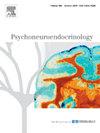社会逆境的历史与青少年的体外炎症反应有关
IF 3.6
2区 医学
Q2 ENDOCRINOLOGY & METABOLISM
引用次数: 0
摘要
社会逆境始终与负面的心理和身体健康结果相关,可能通过炎症过程失调。青春期是这些影响出现的关键时期。传统的慢性炎症基线测量通常无法捕捉炎症反应的动态性质,这突出了评估炎症反应性和对抑制的敏感性的重要性。本研究考察了社会逆境的历史是否能预测青少年的体外炎症反应。方法作为纵向研究的一部分,333名比利时青少年(13.9 ± 0.4岁,44.1 %女孩)在学校通过手指穿刺提供血液样本。用脂多糖孵育血液以评估炎症反应性,用脂多糖加糖皮质激素(GC)孵育血液以评估GC敏感性。检测细胞因子对IL-1β、IL-6和TNF-α的反应。社会逆境,通过自我报告的欺凌受害和成年人在两年内的四波受害来评估,被用作预测因素。线性回归模型调整了性别、青春期状态和感染相关症状,同时考虑了多重测试。结果2年社会逆境史与IL-6 (β=0.119)和TNF-α (β=0.123)反应性相关,与GC敏感性和IL-1β反应性无关。在同时发生的社会逆境和两种逆境分别分析时,观察到相似的模式。结论在该社区青少年样本中,社会逆境与TNF-α和IL-6炎症反应性升高有关。随着时间的推移,这种增加的反应性可能会使青少年患慢性低度炎症的风险。本文章由计算机程序翻译,如有差异,请以英文原文为准。
A history of social adversity is associated with adolescents’ ex vivo inflammatory response
Background
Social adversity is consistently associated with negative mental and physical health outcomes, potentially through dysregulated inflammatory processes. Adolescence is a critical period for these effects to emerge. Traditional baseline measures of chronic inflammation often fail to capture the dynamic nature of inflammatory responses, highlighting the importance of assessing both inflammatory reactivity and sensitivity to inhibition. This study examined whether a history of social adversity predicts adolescents’ ex vivo inflammatory responses.
Methods
As part of the longitudinal Outside-in study, 333 Belgian adolescents (13.9 ± 0.4 years, 44.1 % girls) provided blood samples via fingerprick in a school setting. Blood was incubated with lipopolysaccharide to assess inflammatory reactivity, and with lipopolysaccharide plus glucocorticoid (GC) to assess GC sensitivity. Cytokine responses were measured for IL-1β, IL-6, and TNF-α. Social adversity, assessed through self-reported bullying victimization and victimization by adults over four waves spanning two years, was used as a predictor. Linear regression models adjusted for sex, pubertal status, and infection-related symptoms, while accounting for multiple testing.
Results
A two-year history of social adversity predicted IL-6 (β=0.119) and TNF-α (β=0.123) reactivity but not GC sensitivity or IL-1β reactivity. Similar patterns were observed for concurrent social adversity and for the two types of adversity analyzed separately.
Conclusion
In this community sample of adolescents, social adversity was associated with heightened inflammatory reactivity of TNF-α and IL-6. This increased reactivity might put adolescents at risk of developing chronic low-grade inflammation over time.
求助全文
通过发布文献求助,成功后即可免费获取论文全文。
去求助
来源期刊

Psychoneuroendocrinology
医学-精神病学
CiteScore
7.40
自引率
8.10%
发文量
268
审稿时长
66 days
期刊介绍:
Psychoneuroendocrinology publishes papers dealing with the interrelated disciplines of psychology, neurobiology, endocrinology, immunology, neurology, and psychiatry, with an emphasis on multidisciplinary studies aiming at integrating these disciplines in terms of either basic research or clinical implications. One of the main goals is to understand how a variety of psychobiological factors interact in the expression of the stress response as it relates to the development and/or maintenance of neuropsychiatric illnesses.
 求助内容:
求助内容: 应助结果提醒方式:
应助结果提醒方式:


